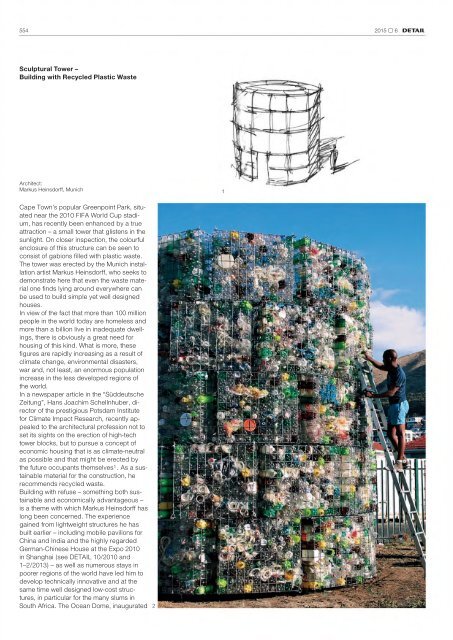Detail english 2015-11-12
You also want an ePaper? Increase the reach of your titles
YUMPU automatically turns print PDFs into web optimized ePapers that Google loves.
554 <strong>2015</strong> ¥ 6 ∂<br />
Sculptural Tower –<br />
Building with Recycled Plastic Waste<br />
Architect:<br />
Markus Heinsdorff, Munich<br />
1<br />
Cape Town’s popular Greenpoint Park, situated<br />
near the 2010 FIFA World Cup stadium,<br />
has recently been enhanced by a true<br />
attraction – a small tower that glistens in the<br />
sunlight. On closer inspection, the colourful<br />
enclosure of this structure can be seen to<br />
consist of gabions filled with plastic waste.<br />
The tower was erected by the Munich installation<br />
artist Markus Heinsdorff, who seeks to<br />
demonstrate here that even the waste material<br />
one finds lying around everywhere can<br />
be used to build simple yet well designed<br />
houses.<br />
In view of the fact that more than 100 million<br />
people in the world today are homeless and<br />
more than a billion live in inadequate dwellings,<br />
there is obviously a great need for<br />
housing of this kind. What is more, these<br />
figures are rapidly increasing as a result of<br />
climate change, environmental disasters,<br />
war and, not least, an enormous population<br />
increase in the less developed regions of<br />
the world.<br />
In a newspaper article in the “Süddeutsche<br />
Zeitung”, Hans Joachim Schellnhuber, director<br />
of the prestigious Potsdam Institute<br />
for Climate Impact Research, recently appealed<br />
to the architectural profession not to<br />
set its sights on the erection of high-tech<br />
tower blocks, but to pursue a concept of<br />
economic housing that is as climate-neutral<br />
as possible and that might be erected by<br />
the future occupants themselves¹. As a sustainable<br />
material for the construction, he<br />
recommends recycled waste.<br />
Building with refuse – something both sustainable<br />
and economically advantageous –<br />
is a theme with which Markus Heinsdorff has<br />
long been concerned. The experience<br />
gained from lightweight structures he has<br />
built earlier – including mobile pavilions for<br />
China and India and the highly regarded<br />
German-Chinese House at the Expo 2010<br />
in Shanghai (see DETAIL 10/2010 and<br />
1–2/2013) – as well as numerous stays in<br />
poorer regions of the world have led him to<br />
develop technically innovative and at the<br />
same time well designed low-cost structures,<br />
in particular for the many slums in<br />
South Africa. The Ocean Dome, inaugurated<br />
2


















